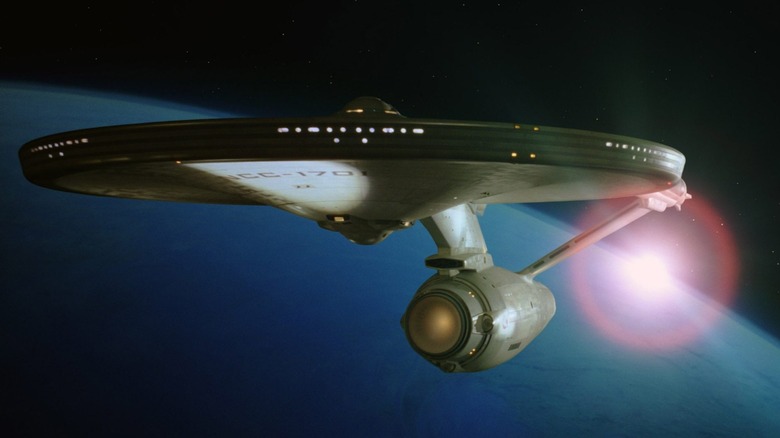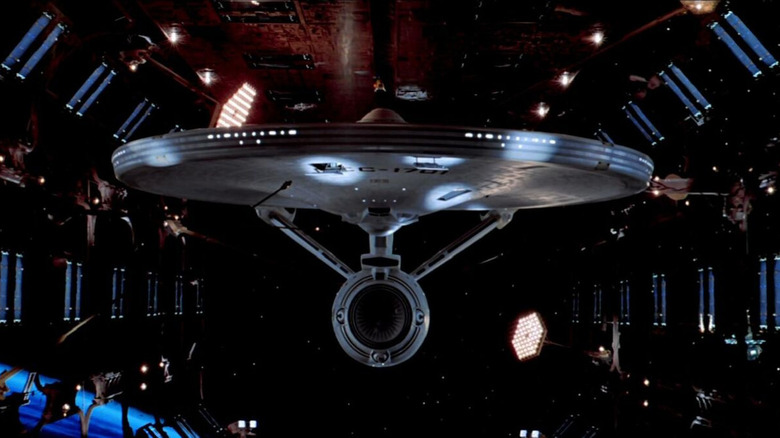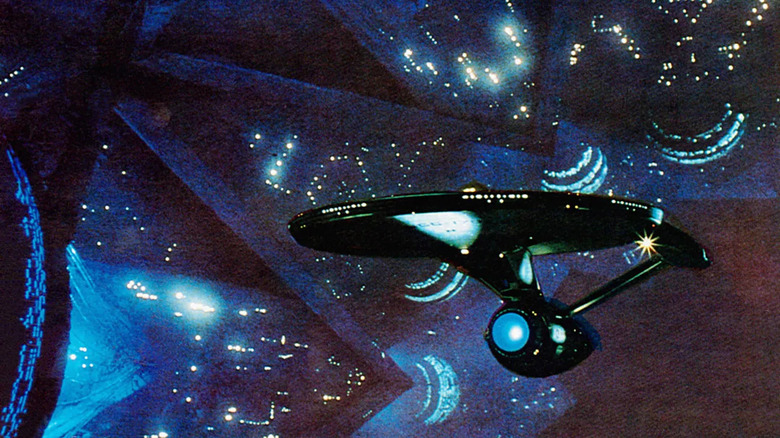Star Trek: The Motion Picture's Crumbling Visual Effects Had Paramount Desperate For Help
In the late Spring of 1979, Paramount Pictures' production of "Star Trek: The Motion Picture" was in big trouble. With a looming release date of December 7 of that year, the film was still struggling to be completed, with the bulk of its visual effects work yet to be even attempted, let alone finished.
In retrospect, given the movie's production history, this was an inevitable problem. Ever since the original "Star Trek" series was cancelled in the summer of 1969, the franchise had experienced a number of stops and starts when it came to being revived. Around the mid-'70s, creator Gene Roddenberry had seemingly set up a script and a production for the show's leap to the big screen, only for Paramount to pivot and seek to turn that work into a proposed reboot of the series back on television, to be known as "Star Trek: Phase II." That show was literal weeks away from beginning filming in 1977, when it was cancelled and the project turned back into a feature film. Finally, the announcement that director Robert Wise would make "Star Trek: The Motion Picture" came in March of 1978.
Just over a year later, principal photography had finished, but the movie's ambitious visual effects were not even close to done, leaving Paramount, Wise, and "The Motion Picture" desperate for help. As it happened, Paramount already had a pioneering visual effects producer on their payroll: Douglas Trumbull, who'd supervised the effects for "2001: A Space Odyssey" and "Close Encounters of the Third Kind," among other films. The issue was that Trumbull had already turned "Star Trek" down and needed more incentive to bail the movie out as it headed for potential disaster.
The trouble with 'Star Trek'
As Trumbull explained to TrekMovie.com's Brian Drew in 2019, in 1979 he was working for Paramount via his own entity, entitled Future General Corporation. Trumbull was hoping to develop "all kinds of new technologies for simulation rides, video games, and motion picture technology — high frame rate, stuff that led to the Showscan process," referring to a process he'd invented which involves 70mm film being projected at 60 frames per second. The filmmaker, who'd directed "Silent Running" earlier in the decade, was also at work developing his next feature as a director, called "Brainstorm."
Sadly, it became clear to Trumbull that Paramount was keeping him around for help on their own productions, like "Star Trek" as it inched closer to its locked release date. Trumbull elaborated on the rock and a hard place the studio found themselves in with the movie, especially with regard to the film's original visual effects company, Robert Abel and Associates. As he explained:
"The production was going ahead, the live action was all shot, but none of the visual effects were working. The company they hired to do the visual effects was basically failing. The studio was extremely upset about it because they were being threatened by a class-action lawsuit from the exhibitors if they didn't deliver the movie on schedule. So that was the dynamics that surrounded the movie, that the exhibitors were going to target Paramount in a class-action lawsuit to kill what they call Blind Bidding, because exhibitors have paid in advance for the right to show the movie. So Paramount was sitting on a bunch of money, I think it was around $30 million dollars in advance payments. And they didn't want to be sued and they didn't want to go bankrupt, so they determined that they had to just pull out all the stops and try to get the movie done."
Trumbull bails out 'Star Trek'
Despite approaching Trumbull earlier about doing the visual effects for "The Motion Picture" and being turned down, a now-desperate Paramount knew they had to negotiate with the filmmaker in order to save "Star Trek." As Trumbull recalled:
"So that's when they re-approached me and basically said, 'What do you need in order to agree to do this job?', which was not something I wanted to do. But I said, 'Okay, I will do the job, but only if I can have Showscan and 'Brainstorm' back. And out of my contract.' So that was the trade-off that we made. You know, in exchange for a hefty fee."
Although Trumbull was victorious in being allowed to get his intellectual property back (with "Brainstorm" getting made a couple years later at MGM, albeit with its own major behind-the-scenes issues), there was still the matter of completing "Star Trek," which was an arduous task even for the veteran effects guru. With just 7 months to complete the film, Trumbull hired John Dykstra, who'd worked on "Silent Running" and, more recently, "Star Wars." Dykstra's then-new effects company, Apogee, employed someone even closer to Trumbull: his father, Don.
Together, father, son, and friend split up the work on "Star Trek," with Trumbull taking on all things Enterprise and Apogee handling the mysterious alien entity known as V'Ger, for instance. Working literally around the clock, Trumbull and company delivered the effects on time, but at a cost: Trumbull found himself checked into the hospital with various ailments for a couple weeks after the film was finished. Although Trumbull was involved with other movies that had troubled production schedules, for him at least, "Star Trek" resembled its tagline: there is no comparison.


